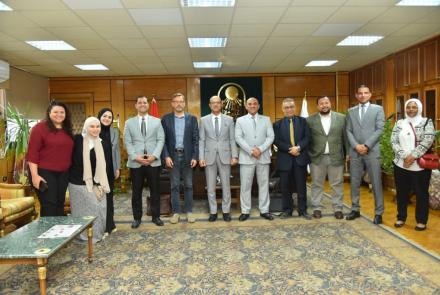The research of Dr. Doaa Ahmed El-Sayed Abou-Taleb,
assistant lecturer of dermatology, venereology & andrology, faculty of Medicine,
Assiut university, entitled (Q-switched Nd:YAG laser versus trichloroacetic acid
peeling in treatment of melasma), under supervision of Prof. Dr. Alaa Eldin Abd
El-Aal Moubasher professor of dermatology, venereology & andrology, and Dr. Eman
Mohamed Kamal Youssef lecturer of dermatology, venereology & andrology, faculty
of Medicine, Assiut university, has awarded the Golden prize of the best
research competition in international conference of dermatology and cosmetology
(Sharm Derma Conference 2014) of the Pan Arab League of Dermatologists during
27-30th November 2014.
The study was carried out to compare between the
efficacy of TCA peeling and double frequency QS-Nd:YAG laser in treatment of
melasma. A total of 65 adult Egyptian female patients with melasma age ranged
from 20 to 52 years old were enrolled in the study. The results showed that the
mean of improvement percentage of MASI score was significantly higher among
group treated with TCA 25%. While group treated with QS-Nd:YAG laser (532 nm &
1064 nm) showed the highest incidence of post-inflammatory hyperpigmentation.
Among all improved patients treated with TCA peel, the percentage of recurrence
of melasma after a three-month post-treatment follow-up period was (32%).
From the previous results, the following points
could be concluded: complete eradication of melasma is very difficult. In our
community, the hot climate, the exposure to sunlight and the dark skin types are
factors that interfere with the permanent cure of melasma. Therefore, avoidance
of sun and heat exposure and the regular use of broad-spectrum sunscreens are
essential for melasma patients. TCA peeling is effective and relatively safe in
treatment of melasma and TCA 25% was the most effective concentration with rare
side effects. Chemical peeling with (TCA) should be used with caution especially
with higher concentrations to avoid the complications.
Lasers have revolutionized the treatment of
dermatological disorders but its place in the management of melasma is still
controversial. Choosing the appropriate laser and the correct settings is vital
in the treatment of melasma to derive maximum efficacy and minimal side effects.
The use of laser should be restricted to cases unresponsive to topical therapy,
chemical peeling, or combination of both of them. Double frequency Q-switched
Nd:YAG laser (532 & 1064 nm) is not recommended for treatment of melasma because
it was associated with the highest incidence of complications such as
post-inflammatory hyperpigmentation. Finally, the appropriate maintenance
therapy such as treatment with broad-spectrum sunscreens and bleaching agents
should be used to avoid relapse of melasma.
The research of Assistant lecturer of dermatology has awarded the Golden prize of the best research competition in international conference of dermatology and cosmetology






